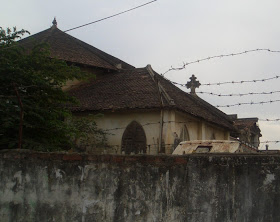












Catholicism never really took off in a big way in Cambodia Vietnam , and among the hill tribes of Vietnam , Laos and Burma
During more recent years of war and strife, many more Cambodians, especially in the border camps, became Christian. Nowadays things are a little different, and besides the Roman Catholics there are a plethora of missionaries, Seventh Day Adventists, Jehovah’s Witnesses and other denominations that operate with varying success and often run large operations around the country. I wasn’t so much interested in these modern churches and their buildings, but more with the older church buildings in Cambodia Kampuchea
This was the first one I went for, mainly because I had seen it so knew it still existed, and also because on an old map it was directly opposite the next one I wanted to look for, on the other side of the huge Tonle Sap River Chrouy Changva Bridge
The Chapel of the Sisters of Providence Hospice.
This sits down a little lane opposite the port. It is completely surrounded by a slum neighborhood, and it was difficult to get a good view of it. It’s a long time since services were held here too; the whole chapel building and all its nooks and crannies have been turned into a bunch of separate living quarters. These are all divided up with light plywood walls, and looking up from any of the living spaces you can see the beautifully plastered old church ceiling. The 4th, 5th and 6th picture are exteriors of this building, and the next one shows the interior ceiling above all the internal partitions.
The site is easily reached by going through a large arch with “Catholic Church” in huge lettering off the main Phnom Penh Cambodia
This was somewhere on the opposite side of the Tonle Sap from where the Kiang Khleang church still is. Although old maps show some big or important roads and intersections around this area, the only one that still matters is National route 5, the road to Oudong. Going anywhere off it entails going down a warren of lanes through wild neighborhoods leading to who knows where, and after much effort I gave up on finding this for now.
Not in Phnom Penh, but high on the Bokor plateau, this place has been mostly silent since the early seventies. It’s a solid concrete construction, and has a strange lay out where the vestry seems to take up a lot more space than the alter and pews. It was the scene of a battle back in 1979 where Khmer Rouge troops took refuge in the church while Vietnamese soldiers fired at them from the Palace Casino a little further up the hill. Back in its day the church was white, but it has by now developed an attractively rustic bright orange lichen and green moss covering. The 10th picture is one I took of Bokor church at sunset in 2005, it almost looks like somewhere in Europe.
Battambang Cathedral
This was an impressive- looking structure in its day, sitting on top of a hill, but unfortunately nothing remains today except the hill. The last picture is of Battambang Cathedral sometime in the early 20th century.
St. Michael's Church Sihanoukville
This was built during the Sangkum Reastre era and was designed by eminent Cambodian architect Van Molyvan along with the Father Ahadobery, a Basque priest. The last picture shows this strangely modern-looking church in 1960.



